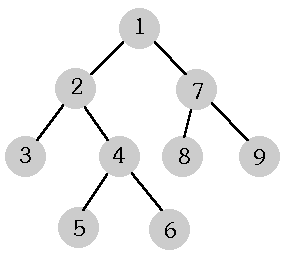
Zadanie Drzewa (drz)
Pomóż nam usprawnić bazę zadań!
Trees
Memory limit: 32 MB
Trees occur very often in computer science. As opposed to trees in nature, computer science trees "grow upside down"; the root is up and the leaves are down.
A tree consists of elements named nodes. A root is one of the nodes. Each node
 (except for the root) has its (exactly one) father
(except for the root) has its (exactly one) father  . If
the node
. If
the node  is the father of
is the father of  , then
, then  is a son
of
is a son
of  . Nodes that have no sons are called leaves. Sons of the node
. Nodes that have no sons are called leaves. Sons of the node
 , their sons, sons of their sons, and so on, are called descendants
of the node
, their sons, sons of their sons, and so on, are called descendants
of the node  . Every node - except for the root - is a descendant of
the root.
. Every node - except for the root - is a descendant of
the root.
Each node has a level number assigned to it. The level number of the root is
 , and the level number of sons is greater by
, and the level number of sons is greater by  then that
of their father.
then that
of their father.
A tree is a complete binary tree if and only if each node has exactly two or zero sons. In binary trees sons are named left and right.
The following picture shows an example of a complete binary tree. The nodes of
that tree are numbered in a special order called preorder. In this order the
root has the number  , a father precedes its sons, and the left son
and any its descendant have smaller numbers than the right son and every its
descendant.
, a father precedes its sons, and the left son
and any its descendant have smaller numbers than the right son and every its
descendant.

There are many written representations of complete binary trees having such numbering of nodes. Three ones follow.
Genealogical representation.
It is a sequence of numbers. The first element of the sequence equals
 (zero), and for
(zero), and for  , the
, the  -th element of
the sequence is the number of the father of the node
-th element of
the sequence is the number of the father of the node  .
.
Bracket representation.
Each node corresponds to a string composed of brackets. Leaves correspond
to
 . Each other node
. Each other node  corresponds to a string
corresponds to a string  , where
, where  and
and  denote the strings that left and
right sons of
denote the strings that left and
right sons of  respectively correspond to. The string the root
corresponds to is the bracket representation of the tree.
respectively correspond to. The string the root
corresponds to is the bracket representation of the tree.
Level representation.
It is a sequence of level numbers of successive tree leaves (according to
the
assumed numbering).
The tree in the picture may be described as follows:
| Genealogical representation | 0 1 2 2 4 4 1 7 7 |
| Bracket representation | ((()(()()))(()())) |
| Level representation | 2 3 3 2 2 |
Task
Write a program that reads from the standard input a sequence of numbers and
examines whether it is the level representation of a complete binary tree. If
not, the program writes one word NIE (" ") in the standard
output. If so, the program finds two other representations of this tree
(genealogical and bracket ones), and writes them in the standard output.
") in the standard
output. If so, the program finds two other representations of this tree
(genealogical and bracket ones), and writes them in the standard output.
Input
In the first line of the standard input there is a positive number of the sequence elements (not greater than 2500). In the second line there are successive elements of the sequence separated by single spaces.
The numbers in the standard input are written correctly. Your program need not verify that.
Output
The standard output should contain:
- either only one word NIE,
- or in the first line - the consecutive elements of the genealogical representation, separated by single spaces; in the second line - the bracket representation, i.e. a sequence of left and right brackets with no spaces between them.
Examples
For the input data:
5 2 2 3 3 2
the correct result is:
0 1 2 2 1 5 6 6 5 ((()())((()())()))
For the input data:
4 1 2 2 3
the correct result is:
NIE
Task author: Wojciech Rytter.
Kontakt
In the event of technical difficulties with Szkopuł, please contact us via email at [email protected].
If you would like to talk about tasks, solutions or technical problems, please visit our Discord servers. They are moderated by the community, but members of the support team are also active there.

 English
English